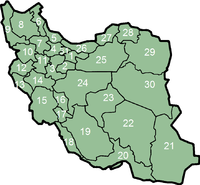Portal:Iran/Featured article

Iranis subdivided into thirty provinces (Persian:استانostān,plural:استانھاostān-hā), each governed from a local center, usually the largest local city, which is called the capital (مرکزmarkaz) of that province. The provincial authority is headed by a governor (استاندارostāndār), who is appointed by the Minister of the Interior subject to approval of thecabinet.
Until 1950, Iran was divided into twelve provinces: Ardalan, Azarbaijan, Baluchestan, Fars, Gilan, Araq-e Ajam, Khorasan, Khuzestan, Kerman, Larestan, Lorestan, and Mazandaran.[1]In 1950, Iran was reorganized to form ten numbered provinces with subordinate governorates: Gilan; Mazandaran; East Azarbaijan; West Azarbaijan; Kermanshah; Khuzestan; Fars; Kerman; Khorasan; Isfahan.[1]From 1960 to 1981 the governorates were raised to provincial status one by one. Since then several new provinces have been created, most recently in2004when the province ofKhorasanwas split into three new provinces.[2]
Each province is further subdivided into sub-provinces calledshahrestan(شهرستانshahrestān), and each shahrestan is subdivided into counties calledbakhsh(بخشbakhsh). There are usually a few cities (شهرshahr) and villages (دهستانdehestān) in each sub-province or county, one of which appointed as the capital of the sub-province or county. According to thewebsite of the Statistical Center of Iran,the figures are as follows, as of March 2005 (end ofIranian Calendar1383):
- Number of Ostans (provinces): 30
- Number of Shahrestans (districts): 324
- Number of Bakhshes (counties): 865
- Number of Shahrs (townships): 982
- Number of Dehestans (rural agglomerations): 2378
References
[edit]- ^abGwillim Law, Statoids website.""Provinces of Iran"".Retrieved2006-04-30.
- ^Online edition, Al-Jazeera Satellite Network.""Iran breaks up largest province"".Retrieved2006-04-30.
